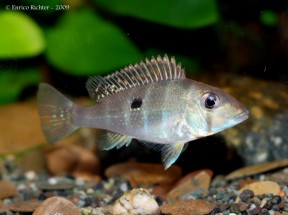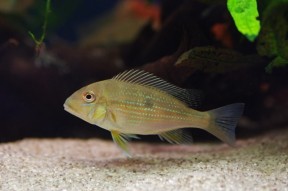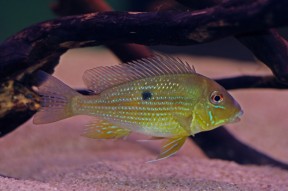Geophagus argyrostictus
Etymology
Geophagus: from the Greek geo, meaning ‘earth’, and phagos, meaning ‘ to eat’.
argyrostictus: from the Greek argyros, meaning ‘silver’, and stiktos, meaning ‘spotted’, in reference to the silvery markings on the anterior portion of the flanks.
Classification
Order: Perciformes Family: Cichlidae
Distribution
Known only from the rio Xingú river system in northeastern Brazil including its major tributary the rio Iriri with type locality given as ‘rocky pool near cachoeira, Belo Monte, Rio Xingu drainage, Pará, Brazil’.
‘Cachoeira’ means ‘waterfall’ in Brazilian Portugese, and the Xingú is a south bank tributary of the Amazon which is home to a significant number of endemic fish species.
G. argyrostictus is apparently widespread in the Xingú and has been collected in both upper and lower parts of the river basin.
Colouration and patterning vary depending on collection locality with populations that are or have been in the hobby including ‘Altamira’, ‘São Félix’ and ‘Tamandua Zinho’.
Habitat
Part of the type series was collected close to the city of Altamira in Pará state with the habitat described as ‘rocky shore areas with clear water’ (Kullander, 1991).
It’s said to show a general preference for clear water environments and tends to inhabit gently sloping marginal zones around shores or islands with substrates of sand, fine gravel and mud.
Depending on locality other habitat features can include scattered rocks, submerged tree roots and branches, and it’s also been collected from floodplain lakes in várzea regions.
Other species occuring in the Xingu are too numerous to mention but the following are some examples of those that have been collected in the same habitats as G. argyrostictus: Anostomus ternetzi, Pseudanos trimaculatus, Acnodon normani, Hyphessobrycon heterorhabdus, H. pulchripinnis, H. scholzei, Moenkhausia collettii, M. intermedia, M. oligolepis, Myloplus rubripinnis, Tetragonopterus argenteus, Triportheus auritus, Hemiodus argenteus, H. unimaculatus, Acaronia nassa, Aequidens michaeli, A. tetramerus, Crenicichla johanna, Geophagus altifrons, Heros severus, Retroculus xinguensis, Satanoperca jurupari, Potamotrygon leopoldi, Callichthys callichthys, Corydoras xinguensis, Hassar orestis, Platydoras costatus, Hypancistrus zebra, Squaliforma emarginata and Scobinancistrus aureatus.
Maximum Standard Length
160 – 180 mm.
Aquarium SizeTop ↑
An aquarium with a base measuring 150 ∗ 45 cm or more is required to house this species long-term.
Maintenance
The most essential item of déco is a soft, sandy substrate so that the fish can browse naturally (see ‘Diet’).
Coarser materials such as gravel or small pebbles can inhibit feeding, damage gill filaments and even be ingested with the potential of internal damage or blockages.
Additional furnishings are as much a case of personal taste as anything else but the most favoured set-ups tend to feature relatively dim lighting plus some chunks of driftwood and scattered roots or branches.
Leaf litter is a typical feature of the natural environment but not really recommended in aquaria because the feeding behaviour of Geophagus spp. tends to cause an excess of partially-decomposed material in suspension which not only looks unsightly but can block filter and pump mechanisms.
One or two flattish, water-worn rocks can also be included to provide potential spawning sites if you wish.
Water quality is of the utmost importance since these cichlids are extremely susceptible to deteriorating water quality and swings in chemical parameters so should never be introduced to a biologically immature aquarium.
The best way to achieve the desired stability is to over-filter the tank using a combination of external canister filters and/or a sump system and perform minimum weekly water changes of 50-70%.
If the maintenance regime is insufficient health issues such as head and lateral line erosion or stunted growth can occur.
Mechanical filtration should also be tailored to trap small particles stirred up by the fish as sand can cause blockages and wearing issues with filter mechanisms if allowed to continually run through the system.
High flow rates should be avoided so position filter returns accordingly.
Water Conditions
Temperature: 26 – 30 °C
pH: 6.0 – 7.5
Hardness: 18 – 179 ppm
Diet
Geophagus spp. are benthophagous by nature, employing a method of feeding whereby mouthfuls of substrate are taken and sifted for edible items with the remaining material expelled via the gill openings and mouth.
For this reason they’re commonly termed ‘eartheaters’ and the provision of a suitable substrate is essential to their long-term well-being.
Once settled they readily rise into the water column when food is introduced but continue to browse normally at other times.
The stomach contents of wild specimens mostly comprise small aquatic and terrestrial invertebrates, plant material in the form of seeds, organic detritus and sediment.
Even as adults these cichlids seem unable to properly ingest larger food items meaning the diet should contain a variety of high quality, fine-grade prepared foods plus small live or frozen bloodworm, Tubifex, Artemia, mosquito larvae, etc.
At least some of the dried products should contain a high proportion of vegetable matter such as Spirulina or similar.
Home-made, gelatine-bound recipes containing a mixture of dried fish food, puréed shellfish, fresh fruit and vegetables, for example, are proven to work well and can be cut into bite-sized discs using the end of a sharp pipette or small knife.
Rather than a single large meal offer 3-4 smaller portions daily to allow natural browsing behaviour as this seems to result in the best growth rate and condition.
Behaviour and CompatibilityTop ↑
G. argyrostictus is markedly more aggressive than most other Geophagus spp. but multiple specimens can still be maintained together in larger aquaria.
A group of 5-8 individuals should be the minimum purchase since in smaller groups weaker individuals can become the target of excessive antagonism.
In terms of tankmates other cichlids are generally best avoided although we know of several instances in which this species has been maintained long-term alongside members of the G. surinamensis complex (see ‘Notes’).
Smaller fishes are generally ignored and schools of small characids can be added without fear of predation.
Some aquarists keep Geophagus spp. alongside freshwater stingrays of the genus Potamotrygon which in many cases has proven successful but in some has resulted in them disappearing at night (!).
Sexual Dimorphism
Juveniles are impossible to sex accurately by external means unless spawning when the ovipositor of the female is clearly visible.
Fully-mature males tend to be a little larger and have longer finnage than females with dominant individuals often developing a pronounced nuchal hump.
Reproduction
Unlike the majority of congeners which practice mouthbrooding this species is a substrate-spawner adopting a fairly basic strategy.
There doesn’t appear to be any particular trigger for the spawning process with the main requirements being good diet and stringent maintenance regime involving relatively large weekly water changes.
Since accurate sexing is essentially impossible it’s best to begin with a group of young fish and allow pairs to form naturally.
A degree of patience is also required since it can be at least a year until they become sexually mature.
Courtship is relatively unobtrusive consisting of fin flaring, circling, gaping and head jerking displays, and when ready to spawn a pair will select a suitable site.
Here they dig a large pit which may be defended for some days before a smaller site is selected within it just prior to spawning.
Other fishes are not tolerated in the vicinity of the pit and in smaller aquaria may need to be removed.
The spawning surface is normally a solid object within the territory of the pair and is cleaned thoroughly before any eggs are deposited.
Spawning occurs in typical style with the female laying one or more rows of eggs before the male moves in to fertilise them, the process being repeated numerous times over a period of an hour or two.
Up to 200-250 eggs may be deposited and the female stays close to them during the incubation period, tending and defending against intruders, while the male is responsible for defence of the surrounding territory.
After around 3 days (70 hours at 27.0°C/80.6°F) the eggs begin to hatch with the female often assisting by literally sucking the fry from the eggs and spitting them into nearby cover.
Post-hatching both adults normally continue to guard the fry for a period although in some cases the female continues alone.
The fry are easily-fed, accepting good quality powdered dry foods, Artemia nauplii, microworm, etc., as soon as the free-swimming stage is reached.
If maintaining the adults in a community situation it’s recommended to remove either tankmates or fry as the latter are easy prey for other fishes, including conspecifics, despite the fact that both parents continue to defend them for some time post-hatching.
NotesTop ↑
This species is relatively rare in the hobby but sometimes available from specialist retailers or private breeders.
Though described in 1991 it was first collected much earlier and misidentified by Gosse (1976) as G. surinamensis.
It’s one of just five Geophagus species not to be included in the putative G. surinamensis ‘group’ of closely-related species within the genus along with G. gottwaldi, G. grammepareius, G. harreri and G. taeniopareius.
These are most easily separated from congeners on the basis that they all possess a complete infraorbital stripe but oddly have not had their own group name assigned, usually being referred to simply as ‘non-G. surinamensis group’ species.
Within this small group G. argyrostictus is distinguished by a combination of characters including: dark infraorbital stripe prominent only on the cheek and not extending to preopercle; possession of silvery reflective scales on the anterior flanks and/or midlateral spot in specimens larger than 70-80 mm SL; midlateral spot rounded or slightly ovate in shape.
Representatives of the G. surinamensis assemblage are diagnosed by their relatively deep head and body shape, possession of a variably-sized dark spot on each flank and presence or absence of a small, dark preopercular marking.
There are currently thirteen described members but diversity is predicted to eventually prove much greater with a number of undescribed forms known some of which, such as G. sp. ‘orange head’ and G. sp. ‘Pindare’, are regularly available in the aquarium trade.
The genus Geophagus was rediagnosed by Kullander (1986) who restricted it to include only those species with paired caudal extensions to the swimbladder lined by 6-12 epihemal ‘ribs’ plus a greater number of caudal than abdominal vertebrae.
Some former species were moved into the resurrected genus Satanoperca while others, such as the ‘Geophagus‘ brasiliensis and ‘G.‘ steindachneri groups represent distinct groupings still in need of definitive classification.
Geophagus and a number of related genera are often included in the putative subfamily Geophaginae.
Kullander (1998) conducted a morphology-based phylogenetic study in which the neotropical Cichlidae was divided into six subfamilies of which the Geophaginae contained 16 genera divided among three ‘tribes’:
Acarichthyini – Acarichthys and Guianacara.
Crenicaratini – Biotoecus, Crenicara, Dicrossus and Mazarunia.
Geophagini – Geophagus, Mikrogeophagus, ‘Geophagus‘ brasiliensis group, ‘Geophagus‘ steindachneri group, Gymnogeophagus, Satanoperca, Biotodoma, Apistogramma, Apistogrammoides and Taeniacara.
Later molecular studies by Farias et al. (1999, 2000, 2001) resulted in the additions of Crenicichla and Teleocichla to the Geophaginae, a result supported by López-Fernández et al. (2005) who conducted the most detailed molecular analysis of the grouping to date including 16 of the 18 genera and 30 species.
However their conclusions regarding interrelationships between genera did vary somewhat from previous hypotheses and can be summarised by the following loosely-defined groups:
– a weakly-supported sister group relationship between Acarichthys and Guianacara.
– a well-supported ‘Satanoperca clade‘ comprising Satanoperca, Apistogramma, Apistogrammoides and Taeniacara.
– a ‘big clade‘ with Geophagus, Mikrogeophagus, ‘Geophagus‘ brasiliensis group, ‘Geophagus‘ steindachneri group, Gymnogeophagus, Biotodoma, Crenicara and Dicrossus.
– a ‘crenicarine clade‘ with Biotoecus and Crenicichla.
No representatives of Teleocichla or Mazarunia were included in the study but the former is well-established as sister to Crenicichla while the latter has grouped closely with Dicrossus and Crenicara in earlier works.
The other main conclusions of the paper are confirmation that Geophaginae is a monophyletic group exhibiting strong signs of having undergone rapid adaptive radiation.
References
- Kullander, S. O., 1991 - Cybium 15(2): 129-138
Geophagus argyrostictus, a new species of cichlid fish from the Rio Xingu, Brazil. - Camargo, M., T.Giarrizzo and V. Isaac, 2004 - Ecotropica 10: 123–147
Review of the Geographic Distribution of Fish Fauna of the Xingu River Basin, Brazil. - Farias, I. P., G. Ortí, I. Sampaio, H. Schneider and A. Meyer, 1999 - Journal of Molecular Evolution 48(6): 703-711
Mitochondrial DNA phylogeny of the family Cichlidae: monophyly and fast molecular evolution of the Neotropical assemblage. - Farias, I. P., G. Ortí, I. Sampaio, H. Schneider and A. Meyer, 2001 - Journal of Molecular Evolution 53(2): 89-103
The cytrochrome b gene as a phylogenetic marker: the limits of resolution for analyzing relationships among cichlid fishes. - Kullander, S. O., 1986 - Swedish Museum of Natural History, Stockholm: 1-431
Cichlid fishes of the Amazon River drainage of Peru. - Kullander, S. O. and H. Nijssen, 1989 - E.J. Brill, Leiden, The Netherlands: i-xxxii + 1-256
The Cichlids of Surinam. - Lucinda, P. H. F., C. A. S. de Lucena and N. C. Assis, 2010 - Zootaxa 2429: 29-42
Two new species of cichlid fish genus Geophagus Heckel from the Rio Tocantins drainage (Perciformes: Cichlidae). - López-Fernández, H. and D. C. Taphorn, 2004 - Zootaxa 439: 1-27
Geophagus abalios, G. dicrozoster and G. winemilleri (Perciformes: Cichlidae), three new species from Venezuela. - López-Fernández, H., R. L. Honeycutt, M. L. J. Stiassny and K. O. Winemiller, 2005 - Zoologica Scripta 34(6): 627-651
Morphology, molecules, and character congruence in the phylogeny of South American geophagine cichlids (Perciformes, Labroidei). - Reis, R. E., S. O. Kullander and C. J. Ferraris, Jr. (eds), 2003 - EDIPUCRS, Porto Alegre: i-xi + 1-729
Checklist of the Freshwater Fishes of South and Central America. CLOFFSCA. - Schindler, I. and W. Staeck, 2006 - Zoologische Abhandlungen (Dresden) 56: 91-97
Geophagus gottwaldi sp. n. - a new species of cichlid fish (Teleostei: Perciformes: Cichlidae) from the drainage of the upper rà o Orinoco in Venezuela. - Staeck, W. and I. Schindler, 2006 - Zoologische Abhandlungen (Dresden) 55: 69-75
Geophagus parnaibae sp. n. -- a new species of cichlid fish (Teleostei: Perciformes: Cichlidae) from the rio Parnaà ba basin, Brazil.










